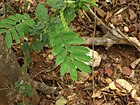Note: This is a project under development. The articles on this wiki are just being initiated and broadly incomplete. You can Help creating new pages.
Albizia amara - Krishnasirish
Albizia amara is a small to moderate-sized, much-branched deciduous tree. it can grow up to 15 metres tall. It has a smooth, dark green, scaly bark. The tree is harvested from the wild for local use as a medicine, source of wood and other materials.
Contents
- 1 Uses
- 2 Parts Used
- 3 Chemical Composition
- 4 Common names
- 5 Properties
- 6 Habit
- 7 Identification
- 8 List of Ayurvedic medicine in which the herb is used
- 9 Where to get the saplings
- 10 Mode of Propagation
- 11 How to plant/cultivate
- 12 Commonly seen growing in areas
- 13 Photo Gallery
- 14 References
- 15 External Links
Uses
Hairfall, Dandruff, Piles, Diarrhea, Gonorrhoea, Leprosy, Boils, Burns, Cough, Malaria, Ulcers [1]
Parts Used
Chemical Composition
The seed extract showed DNA binding activity, which has been found to be due to pithecolibine alkaloids, budmunchiamines. The leaves contain prodelphinidins, myricitrin, hyperin, quercitrin, transp-coumaric acid, cis-p-coumaric acid and trans-ferulic acid. The seeds contain echinocystic acid and taxifolin--O-beta-D xylopyranosyl-beta-D-arbinopyranoside. [2]
Common names
| Language | Common name |
|---|---|
| Kannada | Balukambi, Beelkambi, Chigare |
| Hindi | Kalisirish |
| Malayalam | Chalavagai, Oosulay, Sulivaka |
| Tamil | Arappu, Arappumaram |
| Telugu | Chigara, Chikkareni |
| Marathi | Lulai, Loullei, Thugli |
| Gujarathi | NA |
| Punjabi | NA |
| Kashmiri | NA |
| Sanskrit | Krishnasirish |
| English | Bitter Albizia |
Properties
Reference: Dravya - Substance, Rasa - Taste, Guna - Qualities, Veerya - Potency, Vipaka - Post-digesion effect, Karma - Pharmacological activity, Prabhava - Therepeutics.
Dravya
Rasa
Guna
Veerya
Vipaka
Karma
Prabhava
Habit
Identification
Leaf
| Kind | Shape | Feature |
|---|---|---|
| Bipinnate | Alternate | Stipulate; stipules minute, free, lateral, lanceolate, cauducous; rachis 3-15 cm, slender, pulvinate, with a gland near the base on the upper side, yellow tomentose. |
Flower
| Type | Size | Color and composition | Stamen | More information |
|---|---|---|---|---|
| Bisexual | Heads solitary or 2-3 in axillary fascicles | Pale yellow | 6-8 mm long; peduncle to 5 cm, slender, densely pubescent; bracts to 5 mm, cauducous | Flowering season: March - November |
Fruit
| Type | Size | Mass | Appearance | Seeds | More information |
|---|---|---|---|---|---|
| Pods | 10-24 x 2.5-4 cm | Flat, greyish-brown, veiny, straight or wavy along margin, base and apex rotund, horned, indehiscent | Seeds 6-13, compressed, ovate-orbicular | Fruiting season: March - November |
Other features
List of Ayurvedic medicine in which the herb is used
Where to get the saplings
Mode of Propagation
How to plant/cultivate
Seed - it has a hard seedcoat and may benefit from scarification before sowing to speed up germination. This can usually be done by pouring a small amount of nearly boiling water on the seeds (being careful not to cook them!) and then soaking them for 12 - 24 hours in warm water. By this time they should have imbibed moisture and swollen - if they have not, then carefully make a nick in the seedcoat (being careful not to damage the embryo) and soak for a further 12 hours before sowing. The treated seed can be then sown and will germinate within 7 - 10 days. Germination rate is about 80%. [5]
Commonly seen growing in areas
Dry deciduous forest, Tropical area, Dry area
Photo Gallery
References
External Links
- Ayurvedic Herbs known to be helpful to treat Hairfall
- Ayurvedic Herbs known to be helpful to treat Dandruff
- Ayurvedic Herbs known to be helpful to treat Piles
- Ayurvedic Herbs known to be helpful to treat Diarrhea
- Ayurvedic Herbs known to be helpful to treat Gonorrhoea
- Ayurvedic Herbs known to be helpful to treat Leprosy
- Ayurvedic Herbs known to be helpful to treat Boils
- Ayurvedic Herbs known to be helpful to treat Burns
- Ayurvedic Herbs known to be helpful to treat Cough
- Ayurvedic Herbs known to be helpful to treat Malaria
- Ayurvedic Herbs known to be helpful to treat Ulcers
- Herbs with Leaves used in medicine
- Herbs with Bark used in medicine
- Herbs with Pods used in medicine
- Herbs with Seeds used in medicine
- Herbs with common name in Kannada
- Herbs with common name in Hindi
- Herbs with common name in Malayalam
- Herbs with common name in Tamil
- Herbs with common name in Telugu
- Herbs with common name in Marathi
- Herbs with common name in Sanskrit
- Herbs with common name in English
- Habit - Tree
- Index of Plants which can be propagated by Seeds
- Index of Plants which can be propagated by Cuttings
- Herbs that are commonly seen in the region of Dry deciduous forest
- Herbs that are commonly seen in the region of Tropical area
- Herbs that are commonly seen in the region of Dry area
- Herbs
- Fabaceae







